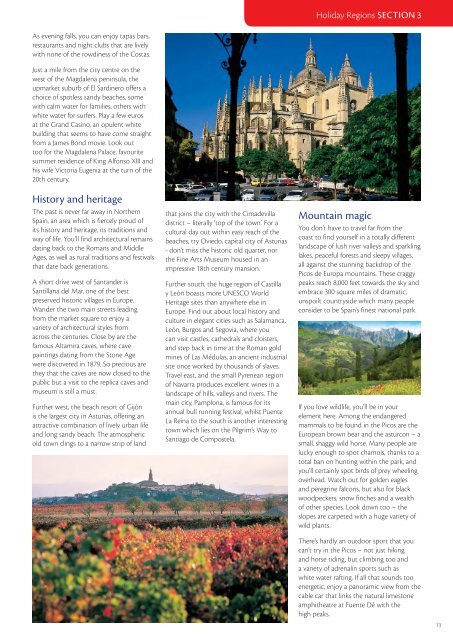France and Spain - Brittany Ferries
France and Spain - Brittany Ferries
France and Spain - Brittany Ferries
Create successful ePaper yourself
Turn your PDF publications into a flip-book with our unique Google optimized e-Paper software.
Holiday Regions SECTION 3<br />
As evening falls, you can enjoy tapas bars,<br />
restaurants <strong>and</strong> night clubs that are lively<br />
with none of the rowdiness of the Costas.<br />
Just a mile from the city centre on the<br />
west of the Magdalena peninsula, the<br />
upmarket suburb of El Sardinero offers a<br />
choice of spotless s<strong>and</strong>y beaches, some<br />
with calm water for families, others with<br />
white water for surfers. Play a few euros<br />
at the Gr<strong>and</strong> Casino, an opulent white<br />
building that seems to have come straight<br />
from a James Bond movie. Look out<br />
too for the Magdalena Palace, favourite<br />
summer residence of King Alfonso XIII <strong>and</strong><br />
his wife Victoria Eugenia at the turn of the<br />
20th century.<br />
History <strong>and</strong> heritage<br />
The past is never far away in Northern<br />
<strong>Spain</strong>, an area which is fiercely proud of<br />
its history <strong>and</strong> heritage, its traditions <strong>and</strong><br />
way of life. You’ll find architectural remains<br />
dating back to the Romans <strong>and</strong> Middle<br />
Ages, as well as rural traditions <strong>and</strong> festivals<br />
that date back generations.<br />
A short drive west of Sant<strong>and</strong>er is<br />
Santillana del Mar, one of the best<br />
preserved historic villages in Europe.<br />
W<strong>and</strong>er the two main streets leading<br />
from the market square to enjoy a<br />
variety of architectural styles from<br />
across the centuries. Close by are the<br />
famous Altamira caves, where cave<br />
paintings dating from the Stone Age<br />
were discovered in 1879. So precious are<br />
they that the caves are now closed to the<br />
public but a visit to the replica caves <strong>and</strong><br />
museum is still a must.<br />
Further west, the beach resort of Gijón<br />
is the largest city in Asturias, offering an<br />
attractive combination of lively urban life<br />
<strong>and</strong> long s<strong>and</strong>y beach. The atmospheric<br />
old town clings to a narrow strip of l<strong>and</strong><br />
that joins the city with the Cimadevilla<br />
district – literally ‘top of the town’. For a<br />
cultural day out within easy reach of the<br />
beaches, try Oviedo, capital city of Asturias<br />
- don’t miss the historic old quarter, nor<br />
the Fine Arts Museum housed in an<br />
impressive 18th century mansion.<br />
Further south, the huge region of Castilla<br />
y León boasts more UNESCO World<br />
Heritage sites than anywhere else in<br />
Europe. Find out about local history <strong>and</strong><br />
culture in elegant cities such as Salamanca,<br />
León, Burgos <strong>and</strong> Segovia, where you<br />
can visit castles, cathedrals <strong>and</strong> cloisters,<br />
<strong>and</strong> step back in time at the Roman gold<br />
mines of Las Médulas, an ancient industrial<br />
site once worked by thous<strong>and</strong>s of slaves.<br />
Travel east, <strong>and</strong> the small Pyrenean region<br />
of Navarra produces excellent wines in a<br />
l<strong>and</strong>scape of hills, valleys <strong>and</strong> rivers. The<br />
main city, Pamplona, is famous for its<br />
annual bull running festival, whilst Puente<br />
La Reina to the south is another interesting<br />
town which lies on the Pilgrim’s Way to<br />
Santiago de Compostela.<br />
Mountain magic<br />
You don’t have to travel far from the<br />
coast to find yourself in a totally different<br />
l<strong>and</strong>scape of lush river valleys <strong>and</strong> sparkling<br />
lakes, peaceful forests <strong>and</strong> sleepy villages,<br />
all against the stunning backdrop of the<br />
Picos de Europa mountains. These craggy<br />
peaks reach 8,000 feet towards the sky <strong>and</strong><br />
embrace 300 square miles of dramatic,<br />
unspoilt countryside which many people<br />
consider to be <strong>Spain</strong>’s finest national park.<br />
If you love wildlife, you’ll be in your<br />
element here. Among the endangered<br />
mammals to be found in the Picos are the<br />
European brown bear <strong>and</strong> the asturcon – a<br />
small, shaggy wild horse. Many people are<br />
lucky enough to spot chamois, thanks to a<br />
total ban on hunting within the park, <strong>and</strong><br />
you’ll certainly spot birds of prey wheeling<br />
overhead. Watch out for golden eagles<br />
<strong>and</strong> peregrine falcons, but also for black<br />
woodpeckers, snow finches <strong>and</strong> a wealth<br />
of other species. Look down too – the<br />
slopes are carpeted with a huge variety of<br />
wild plants.<br />
There’s hardly an outdoor sport that you<br />
can’t try in the Picos – not just hiking<br />
<strong>and</strong> horse riding, but climbing too <strong>and</strong><br />
a variety of adrenalin sports such as<br />
white water rafting. If all that sounds too<br />
energetic, enjoy a panoramic view from the<br />
cable car that links the natural limestone<br />
amphitheatre at Fuente Dé with the<br />
high peaks.<br />
13

















